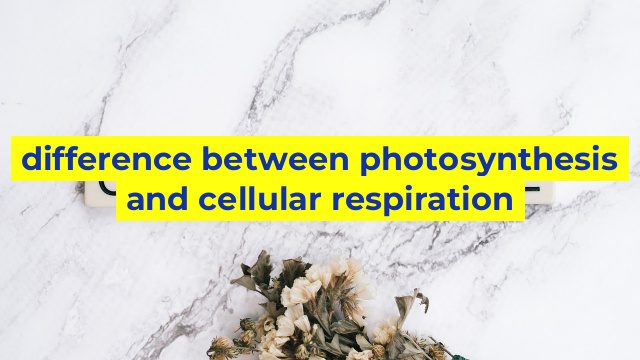The Differences Between Photosynthesis and Cellular Respiration
Photosynthesis and cellular respiration are two fundamental biological processes that are essential for the survival of living organisms. Despite their importance, many people confuse the two terms and use them interchangeably. This article will provide you with a comprehensive understanding of the differences between photosynthesis and cellular respiration.
Definition of Photosynthesis and Cellular Respiration
Photosynthesis is the process by which green plants and some other organisms use energy from the sun to convert carbon dioxide and water into glucose, a type of sugar, and oxygen. This process occurs in chloroplasts within a plant’s cells and requires sunlight energy to take place.
On the other hand, cellular respiration is the process by which living organisms break down glucose molecules into energy through a series of metabolic reactions. The reaction takes place within the mitochondria of a cell, and the energy produced from the reaction is then used by the organism for various cellular activities.
Energy Production
The major difference between photosynthesis and cellular respiration lies in how energy is produced in each process. During photosynthesis, energy from the sun is converted into glucose and oxygen, which serves as food and energy for plants and other organisms. In contrast, during cellular respiration, glucose is broken down into ATP, a type of energy that is used by living organisms for different metabolic activities.
Reactants and Products
Another significant difference between photosynthesis and cellular respiration is the type of reactants and products used in each process. Photosynthesis requires carbon dioxide and water as reactants and yields glucose and oxygen as products. Conversely, cellular respiration requires glucose and oxygen as reactants and yields carbon dioxide and water as products.
Location of Processes
Photosynthesis and cellular respiration take place in different parts of a cell. As mentioned earlier, photosynthesis takes place in the chloroplasts, which are present in green plant cells. In contrast, cellular respiration occurs within the mitochondria of a cell, which is found in both plant and animal cells.
Conclusion
In conclusion, photosynthesis and cellular respiration are two essential biological processes that are distinct in their mechanisms, reactants, and products. Photosynthesis helps to generate food and oxygen for organisms, while cellular respiration helps to break down glucose for energy production. Understanding the differences between the two processes is crucial for understanding the complex interactions of living organisms and how they function in an ecosystem.
Table difference between photosynthesis and cellular respiration
| Feature | Photosynthesis | Cellular Respiration |
|---|---|---|
| Definition | The process by which green plants synthesize food by using sunlight, water, and carbon dioxide | The process by which organisms convert glucose into usable energy |
| Organisms involved | Autotrophs (plants and some bacteria) | Heterotrophs (all organisms including animals, plants, and bacteria) |
| End products | Glucose and oxygen | Carbon dioxide, water, and usable energy (ATP) |
| Location in cell | Chloroplasts | Mitochondria |
| Energy source | Sunlight | Glucose |
| Reactants | Carbon dioxide, water, and sunlight | Glucose and oxygen |
| Overall equation | 6CO2 + 6H2O + sunlight → C6H12O6 + 6O2 | C6H12O6 + 6O2 → 6CO2 + 6H2O + ATP |
